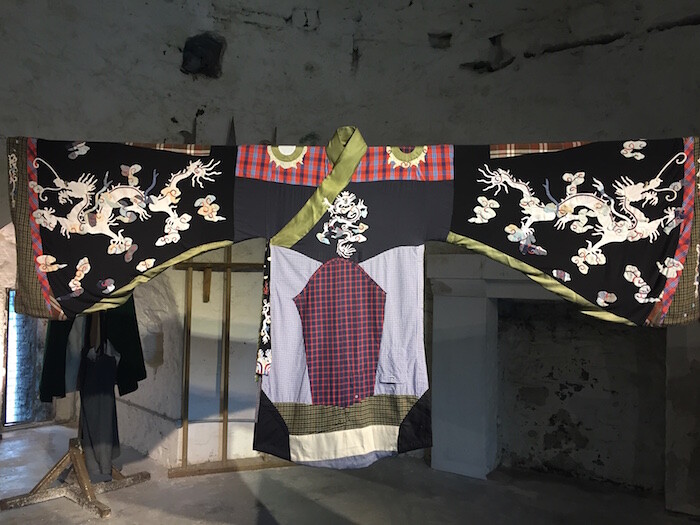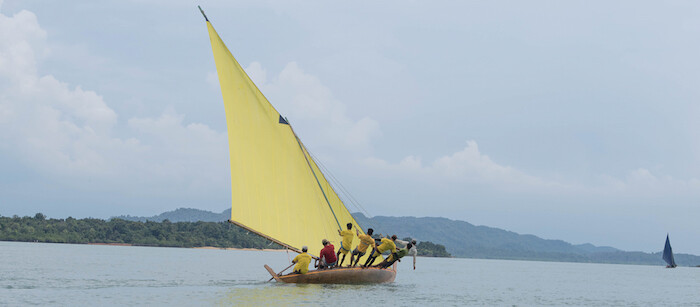In her catalogue introduction, Koyo Kouoh calls Ireland “the first and foremost colonial laboratory of the British enterprise.” It’s a striking statement from the curator of EVA International biennial in Limerick. Titling the biennial “Still (the) Barbarians,” Kouoh uses it as a platform to consider how the legacies of colonialism affect the world today. As Kouoh mentions in her text, post-colonial discourse is scarcely present in the Irish consciousness. (Mythologizing, on the other hand, has long been a powerful tool of the Irish imagination.) This year is the one-hundredth anniversary of the Easter Rising of 1916, including the Proclamation of the Republic by rebel leaders, which began a series of events resulting in the Irish War of Independence of 1919–21 and the subsequent end of British rule. A cursory glance at countless posters advertising anniversary events suggests that this is still the case, though the celebrations have also instigated an opportune, more objective reassessment of history, one that questions, for instance, the wisdom of staging a poorly planned armed uprising in a densely inhabited urban location where innocent bystanders were bound to be killed. There’s also a fresh recognition of how retellings of the Easter Rising in the decades that followed helped stir provincial divisions. Limerick, meanwhile, is a once-great city that has experienced tough times, a fact that is written all over the city’s architecture. Though King John’s Castle, the biennial’s venue for artist Vo Tran Chau, is a magnificent symbol of Norman power, the working docks today use a fraction of their capacity.
The exhibition has two principal venues, the Limerick City Gallery of Art and the run-down Cleeve’s Condensed Milk Factory. Among more than 50 artists included about a dozen are Irish, most of whom steer clear of direct references to the frequently recounted centuries of occupation. Inside one hall off the yard of the Milk Factory Dorothy Hunter’s slender sculptural installation Unassigned Monuments One Through Six (2013) includes photographs propped or adhered to fine steel bars or plasterboard-like annotations, but these refer to disrupted or destroyed monuments, and the whole has an air of a temporary, provisional scaffold. At the same venue, Alan Phelan brings up the ghost of Roger Casement, an Anglo-Irish man who worked for the British Colonial Service, was knighted for his reporting on human rights abuses in the Congo and Peru, and later promoted the Republican cause before being captured and executed shortly after the Rising, but finds new vents for his story. Phelan’s work includes an illuminated sign for “Leopoldville” positioned in the courtyard, written against the purple of Cadbury’s chocolate and in the brand font; in a low nearby shed excerpts of an interview with Colm O’Gorman, Executive Director of Amnesty International in Ireland, are projected. It’s a deliberate scatter-gunning of subject matter and presentation (the interview reduced to a series of short, choppy statements) that render a disordered version of events with thematic links fanning out in numerous directions, back and forward in time to resource exploitation, trade routes, and rights abuses.
The geographic loci beyond Europe are in Africa, Southeast Asia, and South America. At the City Gallery, Olympic sailor turned filmmaker Charles Lim Yi Yong’s Stealing the Trapeze (2016) is a deft re-appropriation. As a schoolboy, Lim stole a book by naturalist Peter Scott from his school library in Singapore, in which Scott describes the invention of the sailing trapeze. Evidence would suggest, however, that the device is derived from one developed long before in the Indonesian Riau Archipelago. The artist doesn’t pass comment, but counters a printed reproduction of Scott’s account with a looping two-screen video of boats under sail in parallel, towards and away from each other.
Throughout the exhibition there are few instances where artists seek a conclusive balance of justice; more frequently artists collate evidence, with Kader Attia’s Reason’s Oxymorons (2015), a library of video interviews with philosophers, ethnologists, historians, psychiatrists, psychoanalysts, musicologists, patients, healers, fetishists, and griots being exemplary of this back at the factory venue. Grouped in thematic collections (“totem and fetish” or “genocide,” for example), the different talking heads communicate a multiplicity of forms of knowledge, belief, and recorded history. Where artists explicitly cite theories of colonialism and decolonization, these are among the array of narrative resources with which they can create new, hybrid forms, as is the case with Larry Achiampong and David Blandy’s video Finding Fanon 2 (2015), installed across a corridor from Attia’s installation, which sees the artists interrogate Frantz Fanon’s ideas while their figures roam through a gaming environment.
There too is Leung Chi Wo’s Untitled (Love for Sale) (2014), which plays on personal histories and coincidence: it includes a light box with an image of Manchester’s Free Trade Hall, beneath which is a button the visitor can press. Doing so illuminates the image, but in a neighboring gallery—thus not immediately apparent—a tall column of newspapers collapses, to be slowly drawn upwards again by a pulley mechanism to an Ella Fitzgerald soundtrack. The causal link is absurd, mournful yet tangentially valid: Fitzgerald had performed at the Hall and died on the same day as the IRA attack on central Manchester in 1996. Bleaker histories are the ingredients for gallows humor in the hands of Kemang Wa Lehulere, whose Teeth are the only bones that show (2016) on the upper storey of the City Gallery references digging and the Limerick Magdalene Laundry in an installation that presents, among other elements, four sets of shiny gnashers on a velvet cushion.
Kouoh has gone for thematic punches, though one bewitching intervention combines the aesthetic and ideas: Michael Joo’s This beautiful striped wreckage (which we interrogate)… (2016) occupies The Sailor’s Home, a mid-nineteenth century edifice originally built as a hostel for seafarers. The structure has been stripped back to its bricks; Joo has reinstated original paneling which framed windows and doors, suspending it from fine wires. Objects found in the nearby docks, like a thick rope heavy with weed, have been hauled in and placed throughout the ground floor, while visitors have to stand on the stairs to see images of an emaciated Buddha projected inside the house’s upper rooms. Joo only posits a temporary costume for the space, holding up the architectural elements like a dress. There are no certainties here, as echoed in the reception of this vision of a starved Buddha, an image and practice rejected in favor of the Middle Way—moderation—of practicing Buddhism.
Skeletons, bodies, and embodying are strains that can be heard throughout the show, from the frames that hold buildings and remain as ruins, to heroic or antiheroic figures. Language is another recurrent theme: the catalogue has for the first time been translated into Irish (none of the content was generated in Irish—in Ireland, like elsewhere, English is the art world’s lingua franca) and there are no written guides. Instead gallery staff are to talk to visitors about individual works. Liam Gillick and Carsten Höller’s works fit the verbal category, the first, And then… (2016), a festival of films described orally in a city-center pub, the latter, One, Some, Many (2016), a microphone linked to a voice recognition system that identifies the most commonly used words in English and plays back programmed responses. These conceptual pieces from the two biggest names in EVA, whose works could slip easily into any given European contemporary exhibition, are those least attuned to it—in contrast to the biennial’s numerous instances of collaboration and collection, they parachute in like the works of isolated individuals.
“The scientist, the scholar, the missionary, the trader, or the soldier was in, or thought about, the Orient because he could be there, or could think about it, with very little resistance on the Orient’s part.” Edward Said’s words (from the introduction to Orientalism, 1978) might seem a topsy-turvy analogy with which to conclude. But within this ambitious show it seems like Limerick and the Irish artists included are reluctant to embrace the lens of a post-colonial reading when other narratives are more pressing. You don’t need to look for colonial bogeymen in the Irish past when there are more recent histories of home-grown abuse—the Catholic Church and its role in the affairs of the state spring to mind—that also are yet to be fully addressed, not to mention current issues like the wave of recent emigration. Not denying the relevance of the colonial legacy but superseding it, looking forward rather than regressing (into yet more storytelling of victimhood). The complexity of shifting, interdependent histories that Kouoh’s enterprise demands and reveals is absolutely fundamental; the post-colonial turn, however, strikes as by the by in an urban site of late capitalism framed by rickety Georgian grandeur and crumbling industrial monoliths. Maybe, as Kouoh suggests, colonialism was too well assimilated, but the Irish Republic’s first independent century has been dramatic, from its beginnings with a bloody civil war up to the recent popular vote for gay marriage. Given an overall budget of three hundred thousand euros, the 2016 EVA is still an astounding achievement; asking that it be more responsive to its site—a requirement that larger biennials generally evade—is vital, because Ireland’s biennial really matters to that site.












